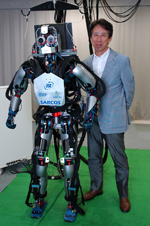Plenary Talks - Mitsuo Kawato
Computational Neuroscience, Brain Decoding and Neurofeedback

Dr. Mitsuo Kawato
Director, ATR Computational Neuroscience Laboratories, Japan
Abstract
Brain science and neuroscience are rapidly growing scientific fields where researchers try to understand information processing of the brain and its application to medicine, engineering and other areas. Computational neuroscience is a theoretical field where mathematical, physical and engineering techniques are utilized. Brain decoding is a new tool to map brain signals onto information, which the signals represent, mainly utilizing machine learning algorithms. Recently, real time neurofeedback is combined with the computational and decoding methods, thus leading to a new causal tool in neuroscience and opening up new therapeutic ways.
Speaker Biography
Mitsuo Kawato received a B.S. degree in physics from Tokyo University in 1976 and M.E. and Ph.D. degrees in biophysical engineering from Osaka University in 1978 and 1981, respectively. From 1981 to 1988, he was a faculty member and lecturer at Osaka University. From 1988, he was a senior researcher and then a supervisor in the ATR Auditory and Visual Perception Research Laboratories. Since 2003, he has been Director of ATR Computational Neuroscience Laboratories. Since 2004, he has been an ATR Fellow. In 2010, he became Director of ATR Brain Information Communication Research Laboratories. From 1996 to 2001, he served as director of the Kawato Dynamic Brain Project, ERATO, JST. From 2004 to 2009, he served as research Supervisor of the Computational Brain Project, ICORP, JST. In 2008, he was jointly appointed as a Research supervisor of PRESTO, JST. He is now concurrently working as a specially appointed visiting professor of Toyama Prefectural University and a visiting professor at Kanazawa Institute of Technology, Nara Institute of Science and Technology, Osaka University, the National Institute for Physiological Sciences, National Institute of Informatics, and graduate school of University of Tokyo, Graduate School of Informatics of Kyoto University, Precision and Intelligence Laboratory of Tokyo Institute of Technology, and Tamagawa University Brain Science Institute.